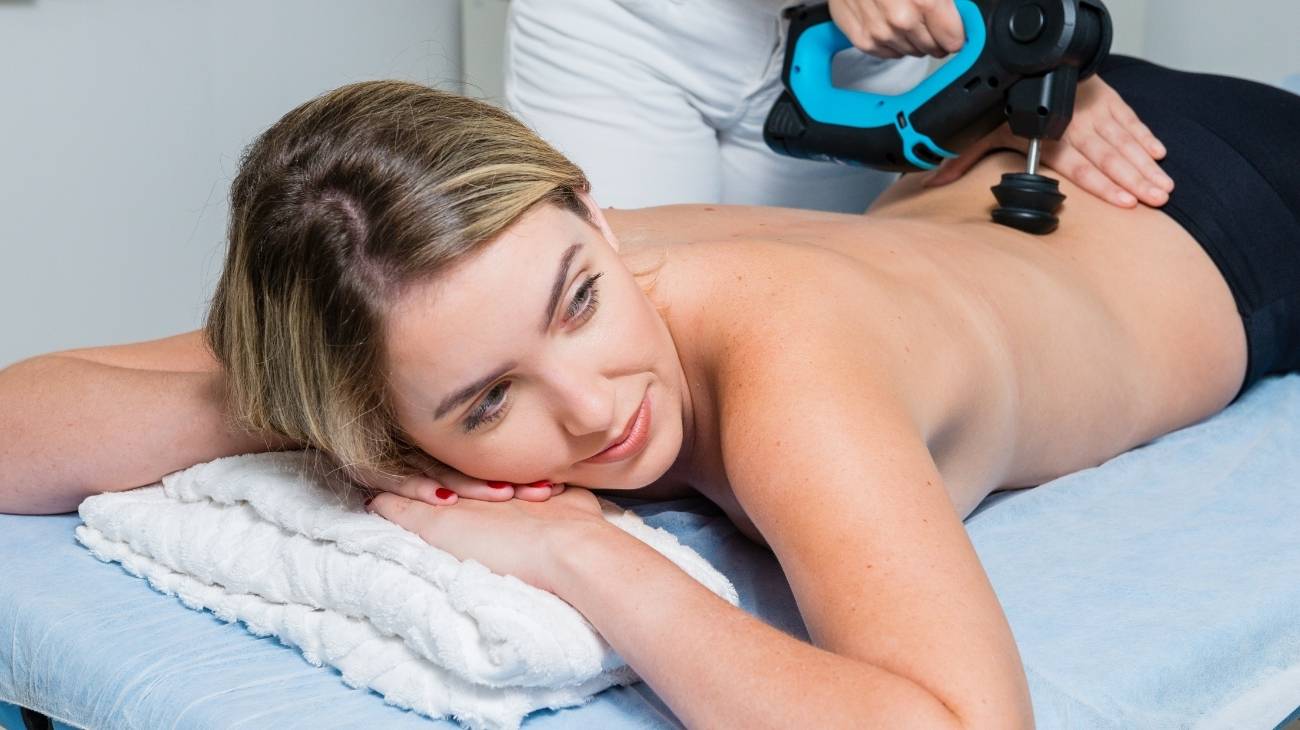- What is myofascial release therapy and how is it used in physical therapy?
- What is myofascial pain syndrome and how to identify it?
- What are the benefits of myofascial release therapy in the treatment of injuries?
- What are the main techniques used in myofascial massage?
- What ailments or injuries can be treated with myofascial release therapy?
- In what sports is myofascial release therapy used to treat injuries?
- What are the contraindications of applying myofascial release therapy?
- F.A.Q: Frequently Asked Questions
Over the years, muscle tissues lose elasticity and firmness, which makes them become sensitive and accumulate tension more easily when performing sports, work or daily activities. In this sense, the fascia is the tissue that usually suffers the most.
When excessive tension accumulates in the fascia, it can generate severe pain known as myofascial pain syndrome. This can be treated in various ways, but the immediate solution is to apply myofascial release therapy, which you will learn about below.
What is myofascial release therapy and how is it used in physical therapy?
Also known as myofascial induction, this therapy consists of the application of manual massage to treat the shortening and tension generated in the myofascial tissue that connects the muscles to the bones and nerves. For this purpose, various massage techniques are used that focus on the so-called trigger points.
The therapy works by releasing all the tension accumulated in an area of myofascial tissue, which is one of the main causes of pain, as well as stretching the tissues so that they relax and the ailment is diluted, generating relief. However, this may not be a total cure for the injury, as at this point the problem may have become chronic.
This is important to know because in many cases myofascial pain is simply a consequence of degenerative diseases of the soft tissues or nerves, so the application of this therapy will only be useful to relieve pain at specific times. Patients with problems such as chronic myofascial pain syndrome, for example, should visit their trusted physiotherapist on an ongoing basis to apply release massages on a regular basis.
bestseller
What is myofascial pain syndrome and how to identify it?
This name is given to chronic muscle pain that occurs due to the constant appearance of the so-called trigger points. When these are created in the myofascial tissue, they often cause pain that in many cases is felt in areas of the body that are apparently unrelated, causing confusion for the physician and the patient.
While we have all felt severe muscle pain in one part of the body at one time or another, the difference with myofascial pain syndrome is that it tends to be persistent and worsen over time, thus becoming a chronic ailment.
What is fascia?
It is a soft tissue that connects muscles to bones, blood vessels and nerves throughout the body. Its function is to give stability to the entire musculoskeletal and nervous system, to help absorb impacts and above all to facilitate the coordination of all these systems so that they move as one, thus creating an uninterrupted network that works throughout the motor system. Tension in the fascia is usually identified and concentrated in the so-called trigger points, which can even cause pain referred to other areas of the body that seem unrelated to their origin.
What are trigger points?
Trigger points are known as areas or regions of pain in a muscle that are palpated as a band or knot in the muscle tissue, or simply a noticeably tight area. The most important characteristic of these points is that 80% of the pain they cause is not located exactly in the area of the point, but is referred to nearby muscle areas.
There are two types of trigger points; main and satellite or secondary. In both cases, to locate them, we proceed to make a touch around the point of pain, until we find a knot or a "ball" that feels tense. This can be done at home without the need of a specialist, as long as you do not try to treat it if you do not know the correct techniques to do so.
What are the causes?
Myofascial pain syndrome can have a myriad of causes that are related to the practice of high-impact sports, or simply by the loss of nutrients and elasticity of the soft tissues over the years.
Among the most common reasons we can identify:
- Poorly treated muscle injuries that become recurrent, this causes the fascia of the muscle in question to deteriorate with each relapse.
- Loss of elasticity and nutrients of muscle tissues that occurs over the years in elderly people.
- Degenerative diseases of the circulatory or nervous system that deteriorate the fascia.
- Muscle wear and tear due to repetitive use.
- Maintaining the same posture for a long time.
- Muscular contusions or traumatisms.
- Misuse of compressive garments in certain areas of the body.
What are the signs and symptoms?
As for the symptoms, myofascial pain is felt in a very particular way that makes it easy for the physiotherapist to identify.
Among the main signs and symptoms are:
- Acute and persistent pain.
- Repetitive, especially after performing a demanding physical activity.
- Difficulty to move the affected muscle without pain.
- Sensitivity to touch in the painful area.
- Tingling and cramps.
- Instability when using the muscle.
- Joint imbalance after a sprain.
- Ringing in the ears
When myofascial pain syndrome is itself a symptom of other degenerative ailments, special attention should be paid to symptoms such as fever, involuntary muscle spasms, joint stiffness or redness of the skin.
What are the benefits of myofascial release therapy in the treatment of injuries?
Myofascial release is not a therapy that can be used only to treat myofascial pain syndrome, but you can also make it a habit to avoid these pains and other ailments related to fascia and trigger points.
Among the benefits you will get by doing so we can identify:
- Release of tension in the muscles and nerves.
- Release of endorphins that reduce general stress and especially muscular stress.
- Reduces the probability of suffering injuries due to wear and tear.
- Increases the resistance of your muscles to fatigue.
- Significantly reduces tissue adhesion to avoid involuntary contractures.
- Increases the radius of joint movement by providing flexibility to tendons and ligaments.
- Reduces post-workout soreness or DOMS (stiffness).
What are the main techniques used in myofascial massage?
Myofascial release is not very different from other massage therapies, with the difference that it focuses on the release of tension in the aforementioned trigger points. To do this, the first thing to do is to identify the point of pain, which is done by palpating the different areas of the body adjacent to the injury until an area of muscle tension is located.
Once this is done, the following massage techniques are applied:
- Rubbing: with the palm of the hand and the fingertips, a gentle rubbing with the skin is initiated without exerting pressure on the muscle tissues. It is an introductory technique that is performed before starting any myofascial release session.
- Friction: in this case we proceed to rub the skin and exert more pressure to stretch and stimulate the underlying muscle tissues. This friction is executed with circular or elliptical movements that seek to release tension in the deeper muscle fibers of the trigger point. The simple application of this method achieves a high level of release and analgesia.
- Deletion: consists of the application of brief pressure on the trigger point using the ulnar edge of the hand and fingertips. Each contact should seek to stretch the tissue they touch, and the pressure should be perfectly calibrated to generate the myofascial release effect sought. The fingers will move like a pianist's fingers on his keyboard, in a coordinated manner.
- Kneading: kneading is a compression technique that is much more "aggressive" than the previous ones. It stretches and compresses the muscle tissue to detach it and move it transversely from one side to the other, so it is necessary to apply oils or creams to prevent skin burns due to the friction generated.
- Vibration: with the hands, the physiotherapist applies static and variable pressure on the localized trigger point, so as to generate a natural vibratory movement that helps to soften the affected tissue and drain excessive tension in it.
A myofascial release session may contain all of these techniques mentioned or only some of them as deemed necessary by the specialist on duty. The duration of each therapy may vary according to the level of tension to which the trigger point is subjected, and you must always be sure that this has been completely released, otherwise you run the risk of a recurrence even stronger than the previous one.
What ailments or injuries can be treated with myofascial release therapy?
Myofascial release can be used on a large number of injuries, as this therapy is very effective in relieving acute pain, and stimulating blood flow to speed recovery of soft tissue ailments in muscles and joints.
Among the most common can be identified:
- Tendonitis: can help relieve pain caused by tendon wear and inflammation, as well as speed recovery by improving blood flow to the affected joint.
- Back pain: pain in the middle and lower back can be easily treated with this therapy, as it reduces stress, releases tension in the vertebrae and relieves pain generated by dorsalgia, lumbalgia and herniated discs.
- Painful shoulder: pain caused by tendonitis or rotator cuff damage, frozen shoulder or humerus fractures can be relieved with the application of this therapy.
- Fibromyalgia: trigger point therapy is very popular for the treatment of widespread muscle pain caused by this chronic condition, reducing its recurrence by a high percentage.
- Carpal tunnel syndrome: applying trigger point therapy to the arm, shoulder and forearm can help reduce and relieve pain caused by inflammation of the median nerve of the carpal tunnel.
- Plantar fasciitis: with this therapy relieves and reduces the recurrence of this injury caused by inflammation of the fascia of the sole of the foot that causes pain in the heel and the base of the toes.
- Temporomandibular dysfunction (TMJ): pain in the jaw joint and surrounding muscles can be treated with the application of myofascial induction which will help reduce pain and prevent it from recurring in the future.
- Thoracic outlet syndrome: can reduce and relieve pain caused by compression of the thoracic opening between the clavicle and the first rib.
- Post-polio syndrome: can reduce the pain and stiffness suffered by polio survivors who are prone to this rare syndrome which, while not life-threatening, can ruin anyone's quality of life.
- Whiplash: useful for reducing tension and relieving pain from damage to the cervical ligaments after a sudden whiplash accident.
- Acute sprains and strains: ideal for relieving pain caused during recovery from a sprain or strain, as well as aiding recovery by improving the quality of blood flow.
In what sports is myofascial release therapy used to treat injuries?
Myofascial release therapy is used more than you might think in the sports world. Not only does it provide many benefits for injury recovery, but it also provides elasticity and increases the radius of joint mobility, which can translate into better performance for any athlete.
That is why it is used in sports such as:
- Football, basketball, handball...
- American football, rugby...
- Tennis, badminton and racquet sports
- Contact sports
- Yoga
- Cycling
- Mountain sports
- Weightlifting
- etc
What are the contraindications of applying myofascial release therapy?
Myofascial induction therapy is very effective and beneficial and the risks are basically nil. However, like any massage technique, it requires the application of friction and constant friction with the skin, so its application is not recommended in case of:
- Acute skin infections.
- Open wounds on the skin.
- Skin burns.
- Bone fractures.
- Severe arterial deficiency.
- Deep vein thrombosis.
F.A.Q: Frequently Asked Questions
References
- Ajimsha, M. S., Al-Mudahka, N. R., & Al-Madzhar, J. A. (2015). Effectiveness of myofascial release: systematic review of randomized controlled trials. Journal of bodywork and movement therapies, 19(1), 102-112. https://www.sciencedirect.com/science/article/abs/pii/S1360859214000862
- McKenney, K., Elder, A. S., Elder, C., & Hutchins, A. (2013). Myofascial release as a treatment for orthopaedic conditions: a systematic review. Journal of athletic training, 48(4), 522-527. https://meridian.allenpress.com/jat/article/48/4/522/191279/Myofascial-Release-as-a-Treatment-for-Orthopaedic
- Beardsley, C., & Škarabot, J. (2015). Effects of self-myofascial release: a systematic review. Journal of bodywork and movement therapies, 19(4), 747-758. https://www.sciencedirect.com/science/article/abs/pii/S136085921500217X
- Laimi, K., Mäkilä, A., Bärlund, E., Katajapuu, N., Oksanen, A., Seikkula, V., ... & Saltychev, M. (2018). Effectiveness of myofascial release in treatment of chronic musculoskeletal pain: a systematic review. Clinical rehabilitation, 32(4), 440-450. https://journals.sagepub.com/doi/abs/10.1177/0269215517732820
- Behm, D. G., & Wilke, J. (2019). Do self-myofascial release devices release myofascia? Rolling mechanisms: a narrative review. Sports Medicine, 49(8), 1173-1181. https://link.springer.com/article/10.1007/s40279-019-01149-y
- Healey, K. C., Hatfield, D. L., Blanpied, P., Dorfman, L. R., & Riebe, D. (2014). The effects of myofascial release with foam rolling on performance. The Journal of Strength & Conditioning Research, 28(1), 61-68. https://journals.lww.com/nsca-jscr/fulltext/2014/01000/the_effects_of_myofascial_release_with_foam.8.aspx
- Arroyo-Morales, M., Olea, N., Martinez, M., Moreno-Lorenzo, C., Daz-Rodrguez, L., & Hidalgo-Lozano, A. (2008). Effects of myofascial release after high-intensity exercise: a randomized clinical trial. Journal of manipulative and physiological therapeutics, 31(3), 217-223. https://www.sciencedirect.com/science/article/abs/pii/S0161475408000328
- Castro-Sánchez, A. M., Matarán-Peñarrocha, G. A., Granero-Molina, J., Aguilera-Manrique, G., Quesada-Rubio, J. M., & Moreno-Lorenzo, C. (2010). Benefits of massage-myofascial release therapy on pain, anxiety, quality of sleep, depression, and quality of life in patients with fibromyalgia. Evidence-Based Complementary and Alternative Medicine, 2011. https://www.hindawi.com/journals/ecam/2011/561753/
- Werenski, J. (2011). The effectiveness of Myofascial release technique in the treatment of Myofascial pain. Lit. Rev, 32, 440-450. https://www.logan.edu/mm/files/LRC/Senior-Research/2011-Aug-34.pdf
- Kalichman, L., & David, C. B. (2017). Effect of self-myofascial release on myofascial pain, muscle flexibility, and strength: a narrative review. Journal of bodywork and movement therapies, 21(2), 446-451. https://www.sciencedirect.com/science/article/abs/pii/S1360859216302625
























